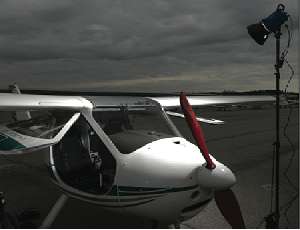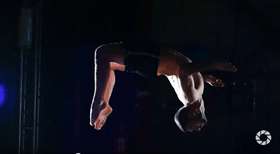Adorama releases an economical location light with consistent flash-to-flash performance.
The following article originally appeared in Professional Photographer Magazine, and is re-posted here with their kind permission. The Flashpoint DG600 300 W/S AC/DC Blue Monolight is available exclusively from Adorama. —The Editor
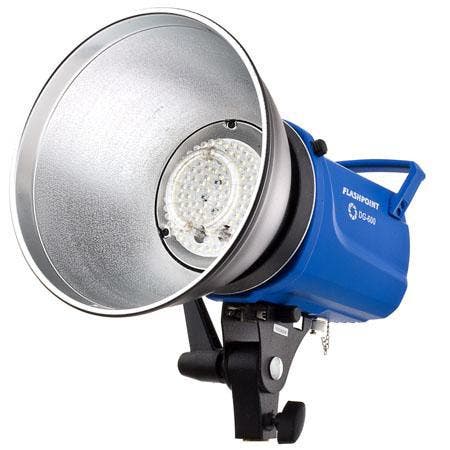
You no doubt know Adorama as a retailer of photographic gear but probably not as a manufacturer of lighting equipment. Technically it isn’t, but its Flashpoint lighting division has been part of the company since the late 1980s. Originally a sales and rental arm, it’s grown to become a distributor of low-cost monolights and light modifiers sold under the Flashpoint brand.
The Flashpoint DG600 300 W/S AC/DC Blue Monolight is well suited for both indoor and outdoor work. Slightly lighter and smaller than the similarly powered Flashpoint 620M II monolight, it’s probably more rugged due to the rubberized layer covering its metal frame. The LED modeling array is definitely more shock resistant than the tungsten bulb modeling light of the 620M. The handle on the back of the flash provides a bit more room for large hands.
FOUR IMPORTANT FEATURES OF THE FLASHPOINT DG600
• The name has nothing to do with its maximum watt-second (Ws) rating: It tops out at 300 Ws.
• It’s blue. Not the light, the body. It’s a bright blue rubberized material over a metal chassis.
• The modeling light is a 7-watt LED array rather than the usual quartz-halogen or tungsten bulb.
• Like other Flashpoint M series monolights, it can be powered by AC or the optional battery pack—great for location work.
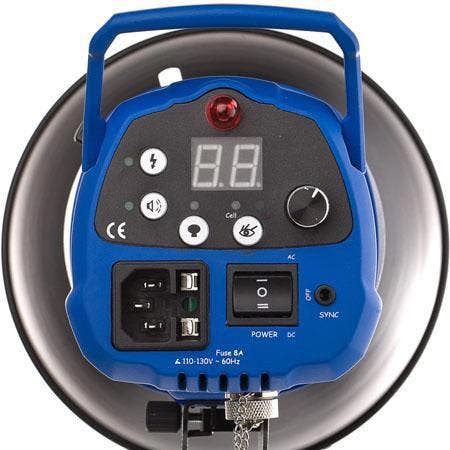
There are big differences in the control layout as well. A large LED has been added for viewing the power setting at a glance in tenth-stop increments on the EU scale, where 300 watt-seconds (Ws) equals 6.6, and stops are measured in whole numbers (e.g., 5.6 yields a full stop less output than 6.6). Output levels are set with a rotating knob, and the power setter (AC, Off, DC) is a rocker switch. All other controls are membrane-covered push buttons labeled with icons rather than words.
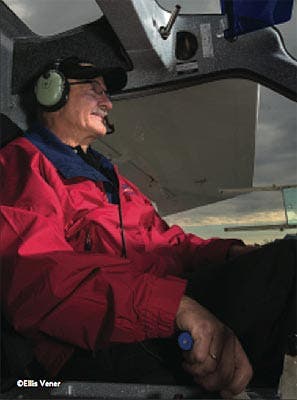
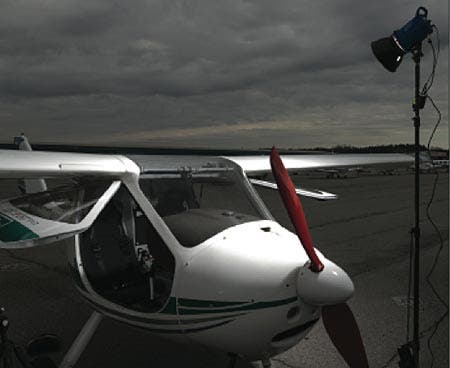
I used the accessory Flashpoint DG battery pack to power the single Adorama Flashpoint DG600 monolight to capture “Flight Instructor.” It was a dark and stormy day with shafts of sunlight occasionally stabbing through the scudding clouds. To emulate that effect, I wanted a hard, crisp light, so I pointed it directly at the plane and used only the standard 8-inch reflector with no diffusion. I triggered the flash using PocketWizard MultiMax transceivers. ©Ellis Vener
The sync cable connection is sized for mini-phone jacks. On the front end, reflectors and speed rings mount via locking bayonet. The combination stand and umbrella mount is lightweight but serviceable for soft boxes.
Good news: At any given output setting, the DG600 is consistent from flash to flash in real-world use, which is not necessarily true of all low-cost monolights. Recycle times are mercifully short, even at full power. The bad news is a little more complicated.
Flashpoint claims the DG600 has a six-stop power range, but in my tests the actual range was 7.4 stops—both a good thing and a bad thing. Having more range means greater versatility, so that’s good. But because of its EU scale, when you’re setting the output, you’d expect that reducing the power from 6.0 to 5.0 would lower the output by one full stop; nope, it reduces power by 1.4 stops. On the other end of the range, the change from minimum power, 1.0, to what should be one stop brighter is also actually 1.4 stops brighter. In the middle range, a 1-stop change is actually 1.2 stops. You can create a cheat sheet, but my advice is to use a flash meter, especially when using multiple lights.
My tests over the entire output range with the grayscale panels of a Datacolor SpyderCheckr target showed a color shift of -800 degrees, which is typical of many flashes that reduce voltage to achieve differences lower than maximum output.
Reducing discharge voltage also lengthens flash duration. While the claimed flash duration range of 1/1,500 to 1/800 second seems plausible, there’s no tool available to verify it.
FLASH DURATION
There are two ISO standards for measuring electronic flash duration: t0.5, the most common, measures the length of time a flash unit emits 50 percent or greater of its peak output. If a flash duration scale is not mentioned in the flash’s marketing materials, assume t0.5.
The more precise t0.1 standard measures all photographically relevant light— everything above 10 percent peak output at a given setting. If you are interested in knowing how well your flash will stop motion, that is the flash duration number you are interested in. It is approximately three times longer than the t0.5 time.
While these findings look dire on paper, they’re fairly consistent with other low-cost monolights and even some of the much more expensive models. The problems are rooted in the way the monolight reduces output power. The DG600 reduces output (watt-seconds) by lowering the voltage (energy) of the electric current going to the flashtube. The result is warmer light and longer flash duration as the output is dialed down.
The use of an LED array as a modeling light is interesting. LEDs are far more efficient, cooler to the touch, longer lasting, and less fragile than the conventionally used tungsten and quartz-halogen bulbs. As there’s practically no heat generated by the modeling light array of the DG600, at the end of the shoot it’s cool enough to pack much sooner than most monolights. The LED array occupies almost the entire back reflector plate behind the flashtube, so it accurately matches the flash’s beam pat- tern. The downside is that once you factor in soft boxes, umbrellas or other light modifiers, and typical light-to-subject distance for portraits, at a 7-watt maximum (about equivalent to a 50-watt tungsten light) it just isn’t bright enough to be anything but minimally useful.
It sounds like I’m pretty down on the Flashpoint DG600 300 W/S AC/DC Blue Monolight monolight but only in comparison to the heavier duty, more expensive lights I usually use. For someone just starting to use flash, they’re a good buy: rugged yet affordable, quick recycling, fairly quiet, lightweight, and small. Consider its ability to use either a light- weight rechargeable battery pack or 100- 130 volts AC, and the Flashpoint DG600 300 W/S AC/DC Blue Monolight is a fine low-cost monolight for shooting both inside and out.
